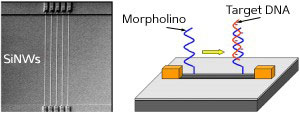| Posted: Oct 13, 2010 |
|
Biosensors: Morpholino offers you more
|
|
(Nanowerk News) Molecular biologists and geneticists often use DNA microarrays to detect DNA, measure gene expression levels and detect the single-nucleotide polymorphisms that are responsible for various genetic diseases. A DNA microarray has tens of thousands of biosensors on its surface; each biosensor contains a short DNA fragment, known as a probe, for recognizing DNA targets. Ideally, the DNA biosensor should have high sensitivity (the ability to detect very low concentrations of targets), high specificity (the ability to distinguish the difference between similar targets) and high stability (the ability to withstand wear and tear over many cycles).
|
 |
| Fig. 1: Scanning electron microscopy image (left) of a cluster of parallel SiNWs, and a schematic illustration (right) of the Morpholino-based sensing mechanism for a single SiNW.
|
|
In recent years, scientists have taken an interest in silicon nanowire (SiNW) biosensors as an option to improve microarray performance. SiNW biosensors are more sensitive than conventional biosensors because probes are functionalized onto the silicon surface, which has a large surface-to-volume ratio. However, SiNW biosensors rely on an electric field for DNA detection, so using negatively charged DNA fragments as probes may interfere with measurement.
|
|
Guo Jun Zhang and co-workers at the A*STAR Institute of Microelectronics have now overcome this problem by using 'Morpholinos' as probes ("Direct patterning in sub-surface of stainless steel using laser pulses"). Morpholinos, first discovered in 1985, are synthetic molecules that structurally resemble naturally occurring DNA molecules. Each Morpholino molecule comprises a nucleic acid base, a morpholine ring and a non-ionic phosphorodiamidate linkage. More importantly, Morpholinos have many properties that are superior to DNA, including higher stability and higher specificity.
|
|
The researchers fabricated SiNW sensors on a 'silicon-on-wafer' substrate (Fig. 1). They then treated the SiNW device with aminopropyltriethoxysilane, glutaraldehyde and Morpholino. X-ray photoelectron spectroscopy showed that the Morpholino molecules were chemically bonded to the silicon surface through glutaraldehyde molecules, and fluorescence microscopy revealed that the Morpholino molecules had been hybridized to the DNA target molecule.
|
|
The researchers tested the performance of their Morpholino-based SiNW device and found that it was extremely sensitive, specific and stable. The sensors responded immediately after the addition of a sample containing DNA targets to the device, even when the concentration of the targets was in the femtomolar range. Adding a sample containing structurally similar non-targets to the device produced no effect. After 20 cycles of hybridization and denaturation, the fluorescence intensity of the Morpholino-modified silicon surface only decreased by about 13%.
|
|
Although the Morpholino-based SiNW biosensors are still at an early stage in development, they are expected to have broad application in future DNA diagnostics.
|

